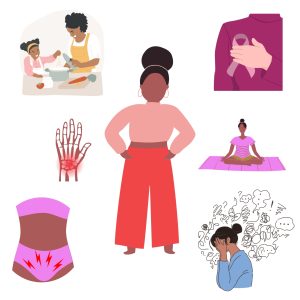2
Holistic Occupational Therapy
 Holistic care encompasses an integrative approach that addresses the individual in their entirety, taking into account not only physical health but also mental, emotional, and social well-being, rather than concentrating solely on isolated symptoms or medical conditions. Holistic practice emphasizes the importance of studying an entire system rather than analyzing individual components in isolation. A holistic perspective can view disability as a “normal” aspect of life, allowing for individual growth through experiences.
Holistic care encompasses an integrative approach that addresses the individual in their entirety, taking into account not only physical health but also mental, emotional, and social well-being, rather than concentrating solely on isolated symptoms or medical conditions. Holistic practice emphasizes the importance of studying an entire system rather than analyzing individual components in isolation. A holistic perspective can view disability as a “normal” aspect of life, allowing for individual growth through experiences.
Western medicine is often seen as reductionist, while Eastern medicine tends to adopt a more holistic approach. A holistic perspective considers culture and the uniqueness of each individual. Holistic practice highlights the significance of a person’s thoughts and feelings regarding health and illness, as well as the healthcare services they choose to access.

The Model of Human Occupation (MOHO) aligns with holistic practices. Over 80% of occupational therapists in the U.S. report using MOHO, as it promotes holistic, occupation-based, evidence-informed, and client-centered care. This theory encourages providers to view clients beyond their personal factors, medical diagnoses, and physical conditions, considering their environment as well. Holistic care involves seeing an individual as a whole, recognizing their unique capabilities and occupations. It also involves addressing additional issues that patients may present beyond their initial concerns. This approach requires providers to be flexible and adaptable, using critical thinking skills to assess other factors that may impact a patient’s ability to achieve independence in daily living.
In hospital settings, the focus may be on ADLs to help patients return home. These include tasks such as dressing, toileting, and eating. However, patients may also require assistance with other important aspects of their lives, such as prayer and attending church, which can be affected by their new diagnosis.
Being client-centered is a crucial aspect of holistic occupational therapy. However, providers must find a balance between treating the whole person and avoiding burnout.
*The following is a supplementary list of theoretical knowledge that may be apply to women’s health within the field of occupational therapy. Please note that this list is not exhaustive.
Models and Theories
Biopsychosocial Model:
- The biopsychosocial model perceives physical and mental health through a multifaceted lens, incorporating biological, psychological, and social perspectives. This model recognizes the interconnectedness of various healthcare components and their collective impact on an individual’s health and wellness. Additionally, it emphasizes the importance of self-awareness and the quality of the provider-patient relationship.
Occupational Adaptation Model (OA):
- Occupational adaptation emphasizes the significance of the factors that individuals identify as important in their lives, particularly in relation to their capacity to conquer challenges associated with the completion of various activities. This concept is frequently associated with the notion of “relative mastery,” which involves the evaluation of success in an activity from the client’s view-point.
Frames of Reference
Biomechanical Frame of Reference:
- The Biomechanical Frame of Reference prioritizes tailoring treatment to address the specific challenges faced by patients, which hinder their ability to perform desired activities. Goals often include training in ADLs to enhance function in the presence of impairments, as well as providing adaptive or compensatory techniques for mobility limitations. Assessments and interventions may involve muscle strengthening, activity tolerance training, and support in completing ADLs, among other approaches.
- During pregnancy, a woman’s body undergoes various physiological changes, including an anterior pelvic tilt, increased lumbar lordosis, a posterior shift in center of gravity, protraction of the shoulders, and alterations in gait patterns.
Cognitive-Behavioral Frame of Reference:
- The Cognitive-Behavioral frame of reference underscores the interplay among various psychological and physiological elements, specifically focusing on individual behaviors, cognitive processes, emotional states, and physiological responses. Additionally, it recognizes the impact of both the social environment, including interpersonal relationships and cultural contexts, and the physical environment, which encompasses the surrounding conditions and settings that can influence mental health and behavior.
- Cognitive Behavioral Therapy (CBT) can serve as an effective therapeutic approach for menopausal women experiencing symptoms such as anxiety, stress, and depression. Additionally, it may assist in managing hot flashes, night sweats, as well as addressing difficulties related to sleep and fatigue.
Key Takeaways
- Holistic occupational therapy is a valuable means of treating the whole person as more than their diagnosis.
Exercises
- Practice verbalizing what holistic occupational therapy means to you. How can holistic occupational therapy benefit your (future) clients?
- How would the KAWA, Occupational Adaptation (OA) Model, and PEOP Model perspectives be applied to women’s health?
- How would the behavioral, psychodynamic, sensory integration, or social participation frames of reference be applied to women’s health?
Explore
References:
Asbjornslett, M., Skarpaas, L. S., & Stigen, L. (2023). “Being holistic is a lot to ask”: A qualitative, cross-national exploration of occupational therapists’ perceptions and experiences of holistic practice. Occupational Therapy International. 10.1155/2023/2432879
Chandler, M. (2021, April 12). 25 OT Frames of Reference. My OT Spot. https://www.myotspot.com/ot-frames-of-reference/
Marschall, A. (2023). Understanding the biopsychosocial model of health and wellness. VerywellMind. http://verywellmind.com/understanding-the-biopsychosocial-model-7549226.
OT Dude. (2025). MOHO. https://www.otdude.com/academy/nbcot-exam-prep/lesson/theories-models/topic/moho/
Physiopedia. (2023). The biomechanics of pregnancy. https://www.physio-pedia.com/index.php?title=The_Biomechanics_of_Pregnancy&oldid=338929
Women’s Health Concern. (2022). Cognitive behaviour therapy (CBT) for menopausal symptoms. https://www.womens-health-concern.org/wp-content/uploads/2023/02/02-WHC-FACTSHEET-CBT-WOMEN-FEB-2023-A.pdf
Media Attributions
- Teal Green Holistic Health Symbolic Logo
- Volition
